A Novel Diamine Containing Ester and Diphenylethane Groups for Colorless Polyimide with a Low Dielectric Constant and Low Water Absorption
Abstract
1. Introduction
2. Materials and Methods
2.1. Materials
2.2. Synthesis of 1,2-Diphenylethane-1,2-diol
2.3. Synthesis of 1,2-Diphenylethane-1,2-diyl bis(4-Nitrobenzoate) (1,2-DPEDBN)
2.4. Synthesis of 1,2-Diphenylethane-1,2-diyl bis(4-Aminobenzoate) (1,2-DPEDBA)
2.5. Preparation of 6FDA-DPEDBA PI and PMDA-ODA PI
2.6. Measurements and Characterization
2.6.1. Melting Point
2.6.2. Molecular Weight
2.6.3. X-ray Diffraction
2.6.4. Thermogravimetric Analysis
2.6.5. Water Absorption and Water Contact Angle
2.6.6. Dielectric Constant
2.6.7. FTIR Spectroscopy
2.6.8. NMR Spectroscopy
2.6.9. UV–Visible Spectroscopy
3. Results and Discussion
3.1. Synthesis and Characterization of the Diamine Monomer
3.2. Synthesis and Characterization of the 6FDA-DPEDBA PI
3.3. Solubility of PI
3.4. X-ray Diffraction of the 6FDA-DPEDBA PI Film
3.5. Properties of the 6FDA-DPEDBA PI Film
3.5.1. Thermal Stability of the 6FDA-DPEDBA PI Film
3.5.2. Optical Properties of the 6FDA-DPEDBA PI Film
3.5.3. Water Absorption and Water Contact Angle of the 6FDA-DPEDBA PI Film
3.5.4. Dielectric Constant of PI Films
4. Conclusions
Author Contributions
Funding
Institutional Review Board Statement
Informed Consent Statement
Data Availability Statement
Acknowledgments
Conflicts of Interest
References
- Ji, D.; Li, T.; Hu, W.; Fuchs, F. Recent progress in aromatic polyimide dielectrics for organic electronic devices and circuits. Adv. Mat. 2019, 31, 1806070. [Google Scholar] [CrossRef]
- Saha, H.N.; Mandal, A.; Sinha, A. Recent trends in the internet of things. In Proceedings of the 2017 IEEE 7th Annual Computing and Communication Workshop and Conference (CCWC), Las Vegas, NV, USA, 9–11 January 2017; pp. 1–4. [Google Scholar] [CrossRef]
- Lvov, V.A.; Senatov, F.S.; Veveris, A.A.; Skrybykina, V.A.; Díaz Lantada, A. Auxetic metamaterials for biomedical devices: Current Situation, main challenges, and research trends. Materials 2022, 15, 1439. [Google Scholar] [CrossRef] [PubMed]
- Bowman, D.; Harte, T.L.; Chardonnet, V.; De Groot, C.; Denny, S.J.; Le Goc, G.; Anderson, M.; Ireland, P.; Cassettari, D.; Bruce, G.D. High-Fidelity Phase and amplitude control of phase-only computer generated holograms using conjugate gradient minimisation. Opt. Express 2017, 25, 11692–11700. [Google Scholar] [CrossRef] [PubMed]
- Xu, L.; Zhou, X.; Tao, Y.; Yu, X.; Yu, M.; Khan, F. AF Relaying secrecy performance prediction for 6G mobile communication networks in industry 5.0. IEEE Trans. Ind. Inform. 2022, 18, 5485–5493. [Google Scholar] [CrossRef]
- Liu, X.; Zhang, X. Rate and energy efficiency improvements for 5G-based IoT with simultaneous transfer. IEEE Internet Things J. 2019, 6, 5971–5980. [Google Scholar] [CrossRef]
- Choi, M.-C.; Hwang, J.-C.; Kim, C.; Ando, S.; Ha, C.-S. New colorless substrates based on polynorbornene-chlorinated polyimide copolymers and their application for flexible displays. J. Polym. Sci. Part A Polym. Chem. 2010, 48, 1806–1814. [Google Scholar] [CrossRef]
- Weber, A.; Deutschbein, S.; Plichta, A.; Habeck, A. 6.3: Thin glass-polymer systems as flexible substrates for displays. SID Symp. Dig. Tech. Pap. 2002, 33, 53–55. [Google Scholar] [CrossRef]
- Shin, H.S.; Koo, J.B.; Jeong, J.K.; Mo, Y.G.; Chung, H.K.; Cheon, J.H.; Choi, J.H.; Kim, K.M.; Hur, J.H.; Park, S.H.; et al. 54.4: 4.1 inch Top-emission AMOLED on flexible metal foil. SID Symp. Dig. Tech. Pap. 2005, 36, 1642–1645. [Google Scholar] [CrossRef]
- Chen, Z.; Zhou, Y.; Wu, Y.; Liu, S.; Huang, H.; Zhao, J. Fluorinated polyimide with polyhedral oligomeric silsesquioxane Aggregates: Toward low dielectric constant and high toughness. Compos. Sci. Technol. 2019, 181, 107700. [Google Scholar] [CrossRef]
- Huang, C.; Li, J.; Xie, G.; Han, F.; Hang, D.; Zhang, F.; Zhang, B.; Zhang, G.; Sun, R.; Wong, C.-P. Low-dielectric constant and low-temperature curable polyimide/POSS nanocomposites. Macromol. Mater. Eng. 2019, 304, 1900505. [Google Scholar] [CrossRef]
- Hasegawa, M.; Ishigami, T.; Ishii, J. Optically transparent aromatic poly (ester imide) s with low coefficients of thermal expansion (1). Self-orientation behavior during solution casting process and substituent effect. Polymer 2015, 74, 1–15. [Google Scholar] [CrossRef]
- Kourakata, Y.; Onodera, T.; Kasai, H.; Jinnai, H.; Oikawa, H. Ultra-low dielectric properties of porous polyimide thin films fabricated by using the two kinds of templates with different particle sizes. Polymer 2021, 212, 123115. [Google Scholar] [CrossRef]
- Leppäniemi, J.; Eiroma, K.; Majumdar, H.; Alastalo, A. Far-UV annealed inkjet-printed In2O3 semiconductor layers for thin-film transistors on a flexible polyethylene naphthalate substrate. ACS Appl. Mater. Interfaces 2017, 9, 8774–8782. [Google Scholar] [CrossRef] [PubMed]
- Zhong, X.; Nag, A.; Zhou, J.; Takada, K.; Amat Yusof, F.A.; Mitsumata, T.; Oqmhula, K.; Hongo, K.; Maezono, R.; Kaneko, T. Stepwise copolymerization of polybenzimidazole for a low dielectric constant and ultrahigh heat resistance. RSC Adv. 2022, 12, 11885–11895. [Google Scholar] [CrossRef] [PubMed]
- Chen, Y.; Zhang, S.; Liu, X.; Pei, Q.; Qian, J.; Zhuang, Q.; Han, Z. Preparation of solution-processable reduced graphene oxide/polybenzoxazole nanocomposites with improved dielectric properties. Macromolecules 2015, 48, 365–372. [Google Scholar] [CrossRef]
- Silverstein, M.S.; Shach-Caplan, M.; Bauer, B.J.; Hedden, R.C.; Lee, H.-J.; Landes, B.G. Nanopore formation in a polyphenylene low-k dielectric. Macromolecules 2005, 38, 4301–4310. [Google Scholar] [CrossRef]
- Liaw, D.J.; Wang, K.L.; Huang, Y.C.; Lee, K.R.; Lai, J.Y.; Ha, C.-S. Advanced polyimide materials: Syntheses, physical properties and applications. Prog. Polym. Sci. 2012, 37, 907–974. [Google Scholar] [CrossRef]
- Kotov, B.V.; Gordina, T.A.; Voishchev, V.S.; Kolninov, O.V.; Pravednikov, A.N. Aromatic polyimides as charge transfer complexes. Polym. Sci. USSR 1977, 19, 711–716. [Google Scholar] [CrossRef]
- Ando, S.; Matsuura, T.; Sasaki, S. Coloration of aromatic polyimides and electronic properties of their source materials. Polym. J. 1997, 29, 69–76. [Google Scholar] [CrossRef]
- Crawford, G.P. Flexible Flat Panel Displays; John Wiley & Sons Ltd: Chichester, UK, 2005; pp. 1–9. [Google Scholar]
- Qian, C.; Bei, R.; Zhu, T.; Zheng, W.; Liu, S.; Chi, Z.; Aldred, M.P.; Chen, X.; Zhang, Y.; Xu, J. Facile strategy for intrinsic low-k dielectric polymers: Molecular design based on secondary relaxation behavior. Macromolecules 2019, 52, 4601–4609. [Google Scholar] [CrossRef]
- Chen, C.K.; Lin, Y.C.; Hsu, L.C.; Ho, J.C.; Ueda, M.; Chen, W.C. High performance biomass-based polyimides for flexible electronic applications. ACS Sustain. Chem. Eng. 2021, 9, 3278–3288. [Google Scholar] [CrossRef]
- Nam, K.-H.; Jin, J.; Lee, D.H.; Han, H.; Goh, M.; Yu, J.; Ku, B.-C.; You, N.-H. Towards solution-processable, thermally robust, transparent polyimide-chain-end tethered organosilicate nanohybrids. Compos. Part B Eng. 2019, 163, 290–296. [Google Scholar] [CrossRef]
- Sun, H.; Lv, Y.; Zhang, C.; Zuo, X.; Li, M.; Yue, X.; Jiang, Z. Materials with low dielectric constant and loss and good thermal properties prepared by introducing perfluorononenyl pendant groups onto poly(ether ether ketone). RSC Adv. 2018, 8, 7753–7760. [Google Scholar] [CrossRef] [PubMed]
- Tao, L.; Yang, H.; Liu, J.; Fan, L.; Yang, S. Synthesis and characterization of highly optical transparent and low dielectric constant fluorinated polyimides. Polymer 2009, 50, 6009–6018. [Google Scholar] [CrossRef]
- Kuo, C.C.; Lin, Y.C.; Chen, Y.C.; Wu, P.H.; Ando, S.; Ueda, M.; Chen, W.C. Correlating the molecular structure of polyimides with the dielectric constant and dissipation factor at a high frequency of 10 GHz. ACS Appl. Polym. Mater. 2021, 3, 362–371. [Google Scholar] [CrossRef]
- Nam, K.-H.; Choi, H.K.; Yeo, H.; You, N.-H.; Ku, B.-C.; Yu, J. Molecular design and property prediction of sterically confined polyimides for thermally stable and transparent materials. Polymers 2018, 10, 630. [Google Scholar] [CrossRef]
- Hasegawa, M.; Hishiki, T. Poly (ester imide) s possessing low coefficients of thermal expansion and low water absorption (V). effects of ester-linked diamines with different lengths and substituents. Polymers 2020, 12, 859. [Google Scholar] [CrossRef]
- Han, S.; Li, Y.; Hao, F.; Qi, S.; Tian, G.; Wu, D. Ultra-low dielectric constant polyimides: Combined efforts of fluorination and micro-branched crosslink structure. Eur. Polym. J. 2021, 143, 110206. [Google Scholar] [CrossRef]
- Chen, Y.C.; Lin, Y.C.; Chang, E.C.; Kuo, C.C.; Ueda, M.; Chen, W.C. Investigation of the structure–dielectric relationship of polyimides with ultralow dielectric constant and dissipation factors using density functional theory. Polymer 2022, 256, 125184. [Google Scholar] [CrossRef]
- Zheng, H.; Wang, C.; Tao, Z.; Jiang, C.; Zhao, X.; Li, J.; Ren, Q. Soluble polyimides containing bulky rigid terphenyl groups with low dielectric constant and high thermal stability. J. Electron. Mater. 2021, 50, 6981–6990. [Google Scholar] [CrossRef]
- Kim, S.D.; Kim, S.Y.; Chung, I.S. Soluble and transparent polyimides from unsymmetrical diamine containing two trifluoromethyl groups. J. Polym. Sci. Part A Polym. Chem. 2013, 51, 4413–4422. [Google Scholar] [CrossRef]
- Bei, R.; Qian, C.; Zhang, Y.; Chi, Z.; Liu, S.; Chen, X.; Xu, J.; Aldred, M.P. Intrinsic low dielectric constant polyimides: Relationship between molecular structure and dielectric properties. J. Mater. Chem. C 2017, 5, 12807. [Google Scholar] [CrossRef]
- Zhang, F.; Li, J.; Liu, F.; Zhang, G.; Sun, R.; Wong, C. Intrinsic low dielectric constant and low dielectric loss polyimides: The effect of molecular structure. In Proceedings of the 2019 20th International Conference on Electronic Packaging Technology (ICEPT), Hong Kong, China, 12–15 August 2019; pp. 1–4. [Google Scholar] [CrossRef]
- Anju, K.S.; Ramakrishnan, S.; Thomas, A.P.; Suresh, E.; Srinivasan, A. 9,10,19,20-Tetraarylporphycenes. Org. Lett. 2008, 10, 5545–5548. [Google Scholar] [CrossRef]
- Chandra, T.; Zebrowski, J.P. Hazards associated with laboratory scale hydrogenations. J. Chem. Health Saf. 2016, 23, 16–25. [Google Scholar] [CrossRef]
- Park, S.S.; Ha, C.-S. Polyimide/hollow silica sphere hybrid films with low dielectric constant. Compos. Interfaces 2016, 23, 831–846. [Google Scholar] [CrossRef]
- Hasegawa, M.; Watanabe, Y.; Tsukuda, S.; Ishii, J. Solution-processable colorless polyimides with ultralow coefficients of thermal expansion for optoelectronic applications. Polym. Int. 2016, 65, 1063–1073. [Google Scholar] [CrossRef]
- Ablajan, K.; Kamil, W.; Tuoheti, A.; Wan-Fu, S. An efficient three component one-pot synthesis of 5-amino-7-aryl-7,8-dihydro-[1,2,4] triazolo[4,3-a]-pyrimidine-6-carbonitriles. Molecules 2012, 17, 1860–1869. [Google Scholar] [CrossRef]
- Nam, K.-H.; Kim, H.; Choi, H.K.; Yeo, H.; Goh, M.; Yu, J.; Hahn, J.R.; Han, H.; Ku, B.-C.; You, N.-H. Thermomechanical and optical properties of molecularly controlled polyimides derived from ester derivatives. Polymer 2017, 108, 502–512. [Google Scholar] [CrossRef]
- Chen, W.; Liu, F.; Ji, M.; Yang, S. Synthesis and characterization of low-CTE polyimide films containing trifluoromethyl groups with water-repellant characteristics. High Perform. Polym. 2017, 29, 501–512. [Google Scholar] [CrossRef]
- Hasegawa, M. Development of solution-processable, optically transparent polyimides with ultra-low linear coefficients of thermal expansion. Polymers 2017, 9, 520. [Google Scholar] [CrossRef]
- Jeong, K.-M.; Li, Y.; Yoo, D.-G.; Lee, N.-K.; Lee, H.-G.; Ando, S.; Ha, C.-S. Effects of crosslinking agents on the physical properties of polyimide/amino-functionalized graphene oxide hybrid films. Polym. Int. 2018, 67, 588–597. [Google Scholar] [CrossRef]
- Harris, F.W.; Lin, S.-H.; Li, F.; Cheng, S.Z.D. Organo-soluble polyimides: Synthesis and polymerization of 2,2′-disubstituted-4,4′,5,5′-biphenyltetracarboxylic dianhydrides. Polymer 1996, 37, 5049–5057. [Google Scholar] [CrossRef]
- Liaw, D.-J.; Fan, C.-L.; Lin, C.-C.; Wang, K.-L. Synthesis and characterization of new soluble poly (ester-imide) s containing noncoplanar 2,2′-dimethyl-4,4′-biphenylene Unit. J. Appl. Polym. Sci. 2004, 92, 2486–2493. [Google Scholar] [CrossRef]
- Tapaswi, P.K.; Ha, C.-S. Recent Trends on Transparent colorless polyimides with balanced thermal and optical properties: Design and synthesis. Macromol. Chem. Phys. 2019, 220, 1800313. [Google Scholar] [CrossRef]
- He, X.; Tapaswi, P.K.; Ha, C.-S.; Huang, W. Soluble polyimides derived from a novel aromatic diamine containing an imidazole unit and trifluoromethyl groups. Macromol. Res. 2021, 29, 365–375. [Google Scholar] [CrossRef]
- Deng, B.; Zhang, S.; Liu, C.; Li, W.; Zhang, X.; Wei, H.; Gong, C. Synthesis and properties of soluble aromatic polyimides from novel 4{,}5-diazafluorene-containing dianhydride. RSC Adv. 2018, 8, 194–205. [Google Scholar] [CrossRef]
- Matsumoto, T.; Mikami, D.; Hashimoto, T.; Kaise, M.; Takahashi, R.; Kawabata, S. Alicyclic polyimides a colorless and thermally stable polymer for opto-electronic devices. J. Phys. Conf. Ser. 2009, 187, 012005. [Google Scholar] [CrossRef]
- Huang, J.; He, C.; Xiao, Y.; Mya, K.Y.; Dai, J.; Siow, Y.P. Polyimide/POSS nanocomposites: Interfacial interaction, thermal properties and mechanical properties. Polymer 2003, 44, 4491–4499. [Google Scholar] [CrossRef]
- Bershtein, V.A.; Egorova, L.M.; Yakushev, P.N.; Pissis, P.; Sysel, P.; Brozova, L. Molecular dynamics in nanostructured polyimide–silica hybrid materials and their thermal stability. J. Polym. Sci. Part B Polym. Phys. 2002, 40, 1056–1069. [Google Scholar] [CrossRef]
- Kong, J.-Y.; Choi, M.-C.; Kim, G.Y.; Park, J.J.; Selvaraj, M.; Han, M.; Ha, C.-S. Preparation and properties of polyimide/graphene oxide nanocomposite films with Mg ion crosslinker. Eur. Polym. J. 2012, 48, 1394–1405. [Google Scholar] [CrossRef]
- Liu, J.; Zhang, H.-B.; Xie, X.; Yang, R.; Liu, Z.; Liu, Y.; Yu, Z.-Z. Multifunctional, superelastic, and lightweight MXene/polyimide aerogels. Small 2018, 14, 1802479. [Google Scholar] [CrossRef]
- Tapaswi, P.K.; Choi, M.-C.; Jeong, K.M.; Ando, S.; Ha, C.-S. Transparent aromatic polyimides derived from thiophenyl-substituted benzidines with high refractive index and small birefringence. Macromolecules 2015, 48, 3462–3474. [Google Scholar] [CrossRef]
- Yang, G.; Zhang, R.; Huang, H.; Liu, L.; Wang, L.; Chen, Y. Synthesis of novel biobased polyimides derived from isomannide with good optical transparency, solubility and thermal stability. RSC Adv. 2015, 5, 67574–67582. [Google Scholar] [CrossRef]
- Pal, B.; Dhara, S.; Giri, P.K.; Sarkar, D. Room temperature ferromagnetism with high magnetic moment and optical properties of Co doped ZnO nanorods synthesized by a solvothermal route. J. Alloy. Compd. 2014, 615, 378–385. [Google Scholar] [CrossRef]
- Meulenkamp, E.A. Synthesis and growth of ZnO nanoparticles. J. Phys. Chem. B 1998, 102, 5566–5572. [Google Scholar] [CrossRef]
- Choi, M.-C.; Hwang, J.-C.; Kim, C.; Kim, Y.; Ha, C.-S. Synthesis of poly(N-9-ethylcarbazole-exo-norbornene-5,6-dicarboximide) for hole-transporting layer in hybrid organic light-emitting devices. J. Polym. Sci. Part A Polym. Chem. 2010, 48, 5189–5197. [Google Scholar] [CrossRef]
- DuPont KAPTON Summary of Properties. Available online: https://www.dupont.com/content/dam/dupont/amer/us/en/products/ei-transformation/documents/EI-10142_Kapton-Summary-of-Properties.pdf (accessed on 15 September 2022).
- Ebisawa, S.; Ishii, J.; Sato, M.; Vladimirov, L.; Hasegawa, M. Spontaneous molecular orientation of polyimides induced by thermal imidization (5). effect of ordered structure formation in polyimide precursors on CTE. Eur. Polym. J. 2010, 46, 283–297. [Google Scholar] [CrossRef]
- Hasegawa, M.; Hirai, T.; Ishigami, T.; Takahashi, S.; Ishii, J. Optically transparent aromatic poly (ester imide) s with low coefficients of thermal expansion. 2: Efect of the introduction of alkyl-substituted p-biphenylene units. Polym. Int. 2018, 67, 431–444. [Google Scholar] [CrossRef]
- Zhu, T.; Yu, Q.; Zheng, W.; Bei, R.; Wang, W.; Wu, M.; Liu, S.; Chi, Z.; Zhang, Y.; Xu, J. Intrinsic high-k–low-loss dielectric polyimides containing ortho-position aromatic nitrile moieties: Reconsideration on clausius–mossotti equation. Polym. Chem. 2021, 12, 2481–2489. [Google Scholar] [CrossRef]
- Chen, C.-K.; Lin, Y.-C.; Miyane, S.; Ando, S.; Ueda, M.; Chen, W.-C. Thermally and mechanically stable polyimides as flexible substrates for organic field-effect transistors. ACS Appl. Polym. Mater. 2020, 2, 3422–3432. [Google Scholar] [CrossRef]
- Huang, J.-J.; Chen, Y.-P.; Lien, S.-Y.; Weng, K.-W.; Chao, C.-H. High mechanical and electrical reliability of bottom-gate microcrystalline silicon thin film transistors on polyimide substrate. Curr. Appl. Phys. 2011, 1, S266–S270. [Google Scholar] [CrossRef]
- Yan, M.; Kim, T.W.; Erlat, A.G.; Pellow, M.; Foust, D.F.; Liu, J.; Schaepkens, M.; Heller, C.M.; McConnelee, P.A.; Feist, T.P.; et al. A transparent, high barrier, and high heat substrate for organic electronics. Proc. IEEE 2005, 93, 1468–1477. [Google Scholar] [CrossRef]
- Maier, G. Low dielectric constant polymers for microelectronics. Prog. Polym. Sci. 2001, 26, 3–65. [Google Scholar] [CrossRef]
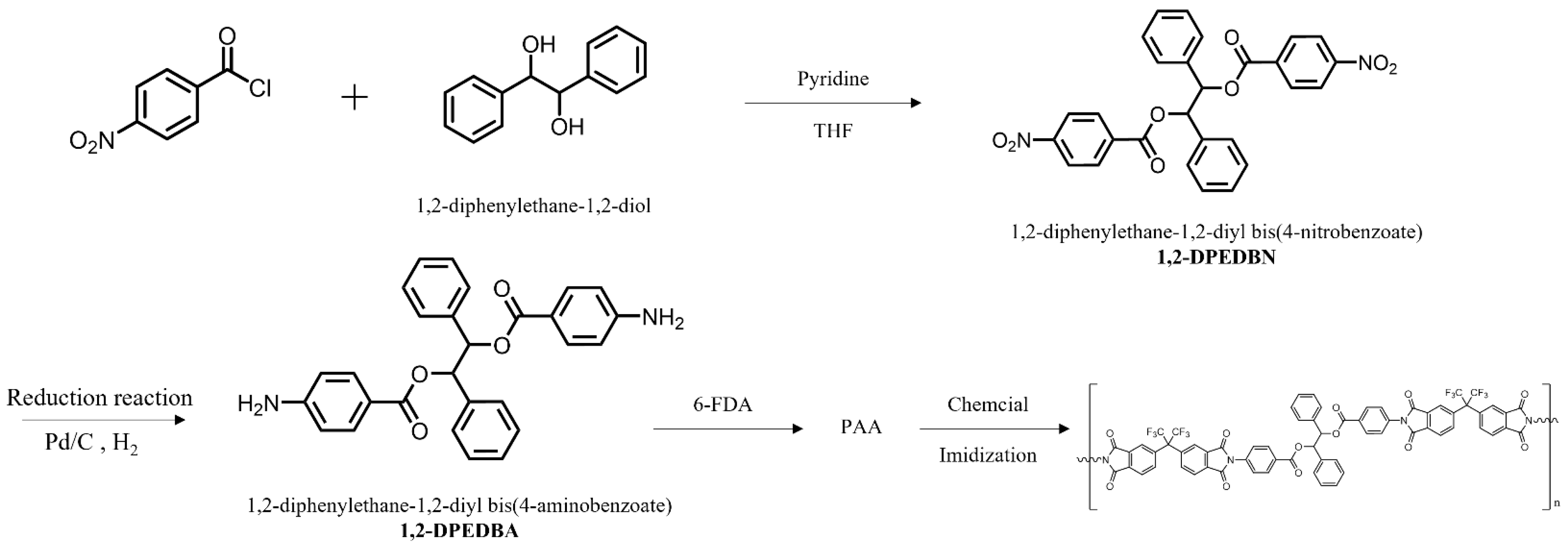
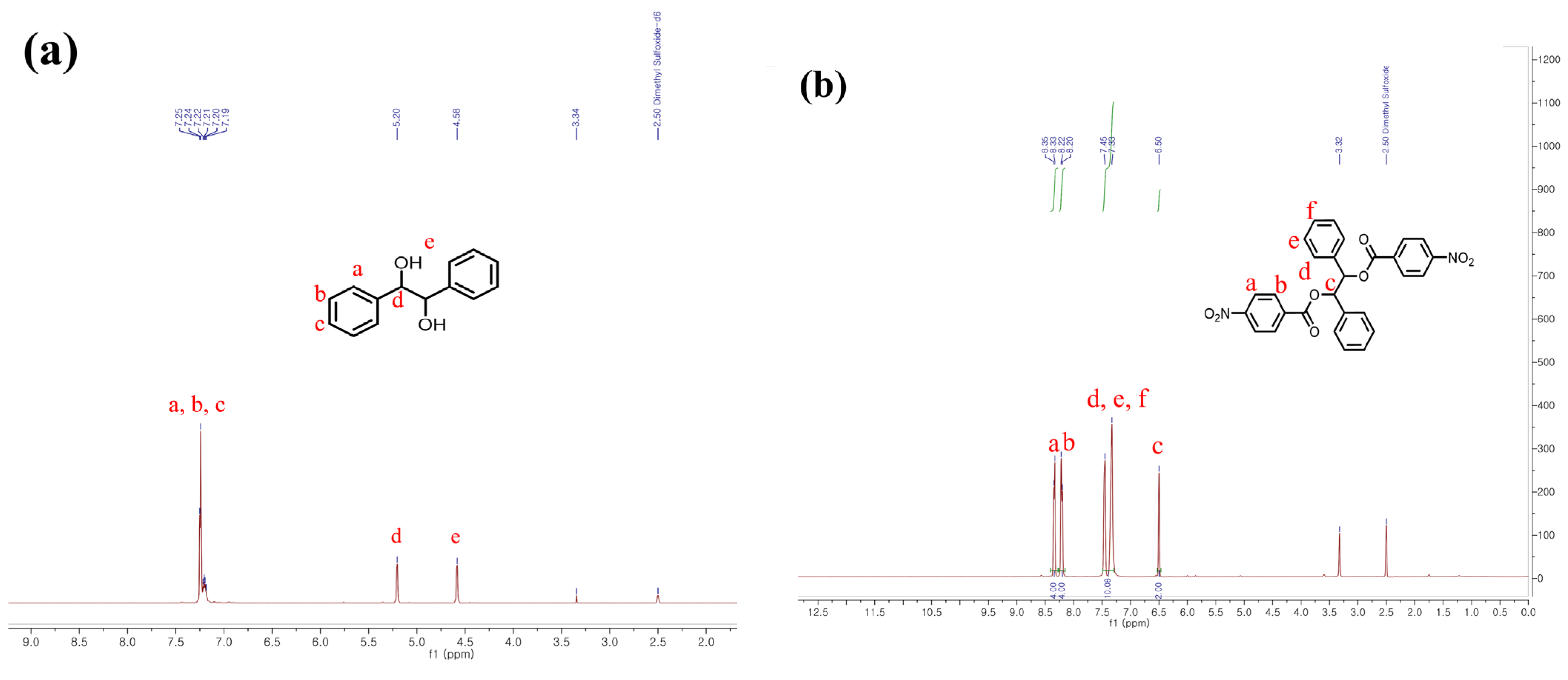
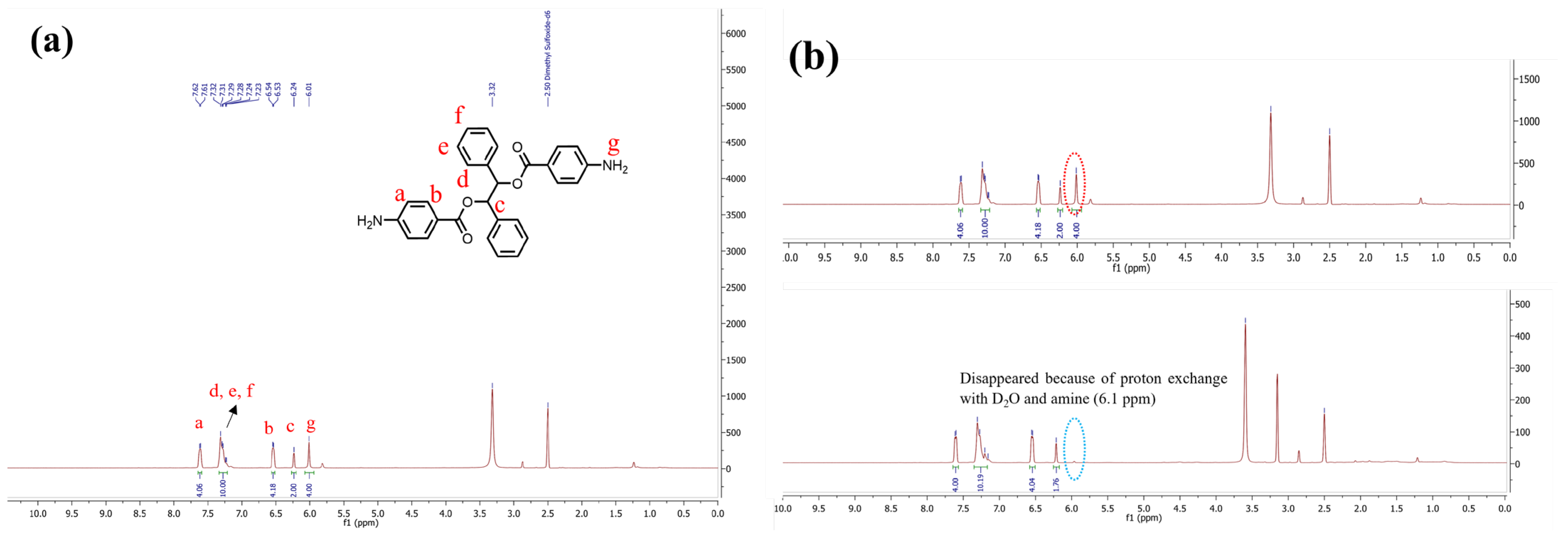
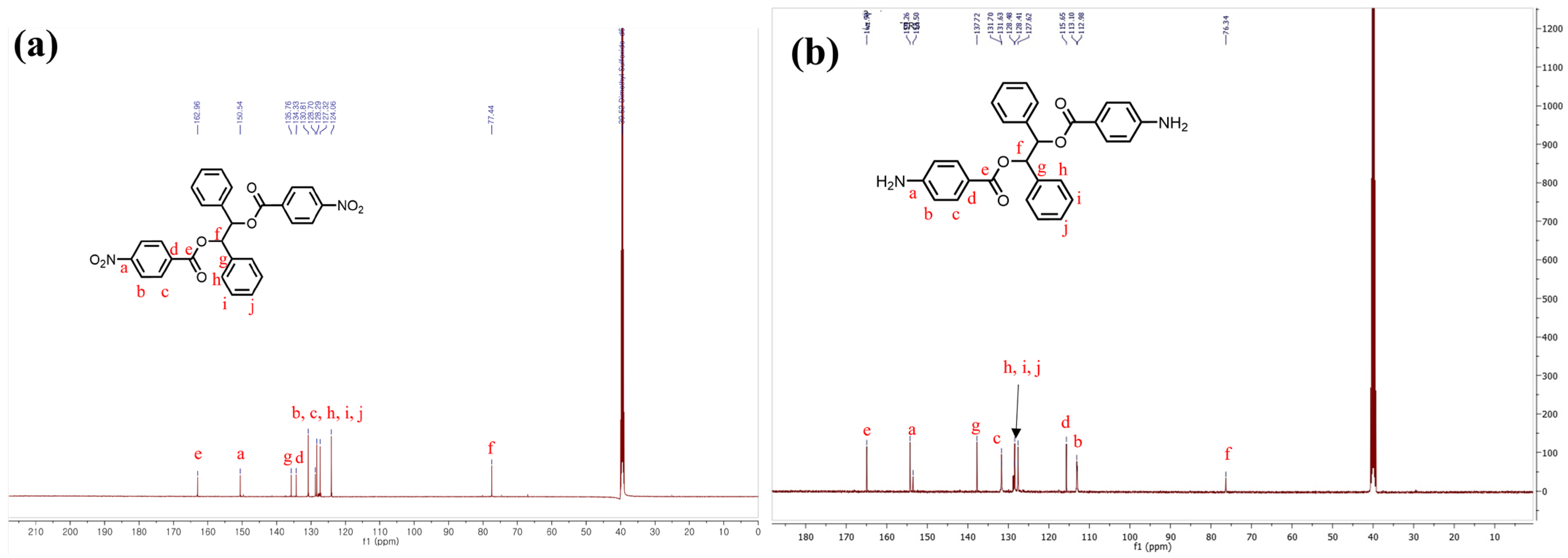
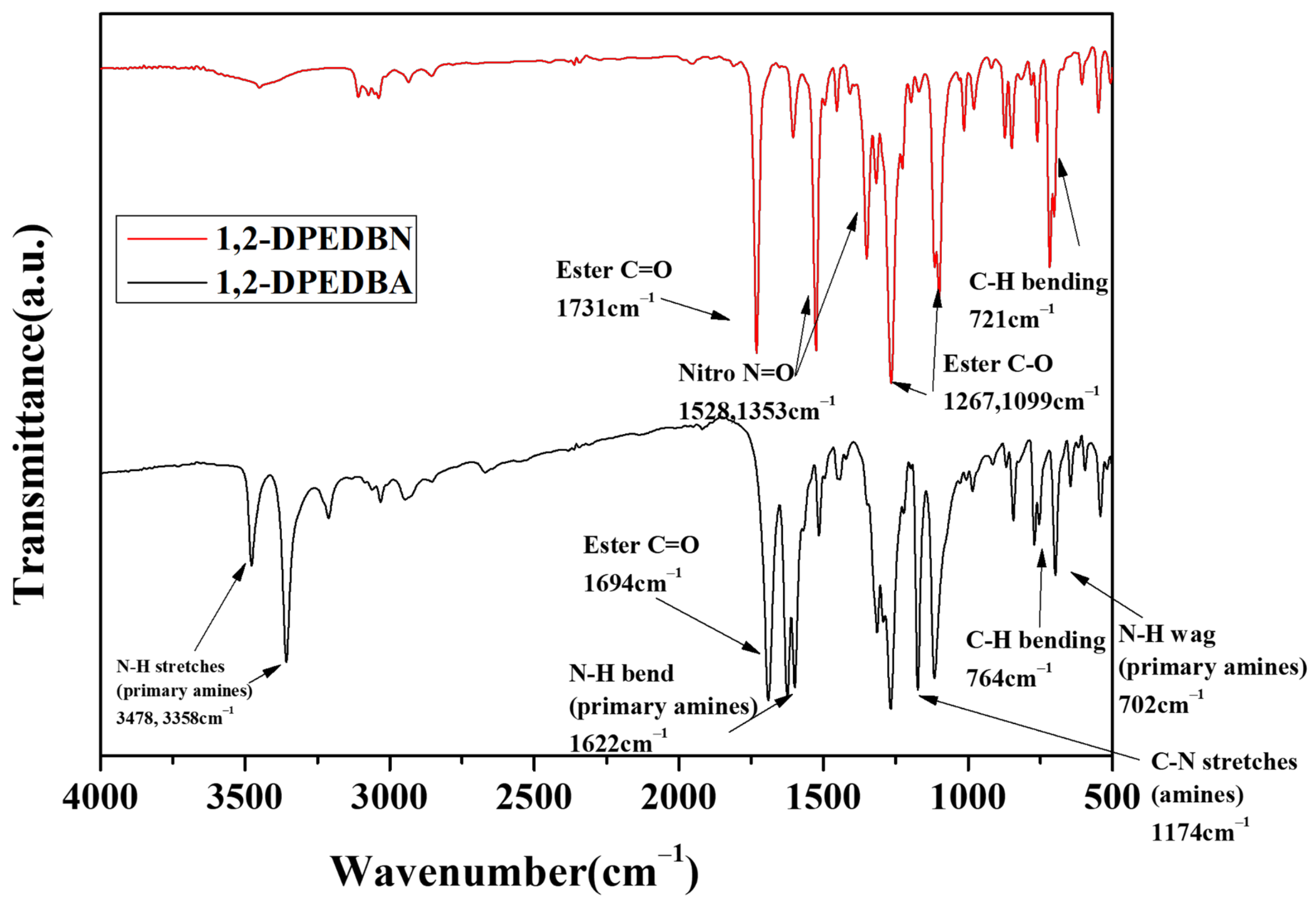
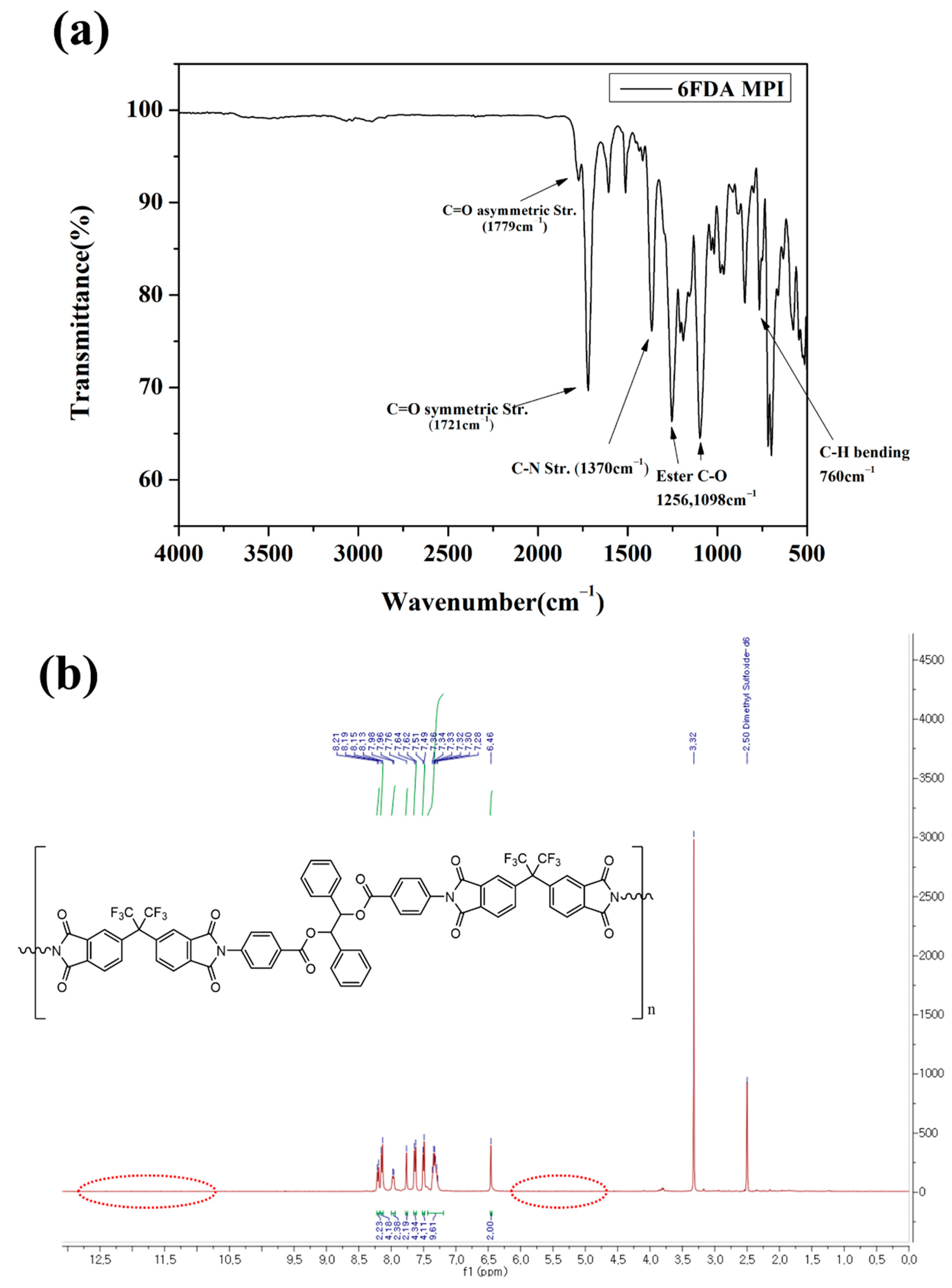
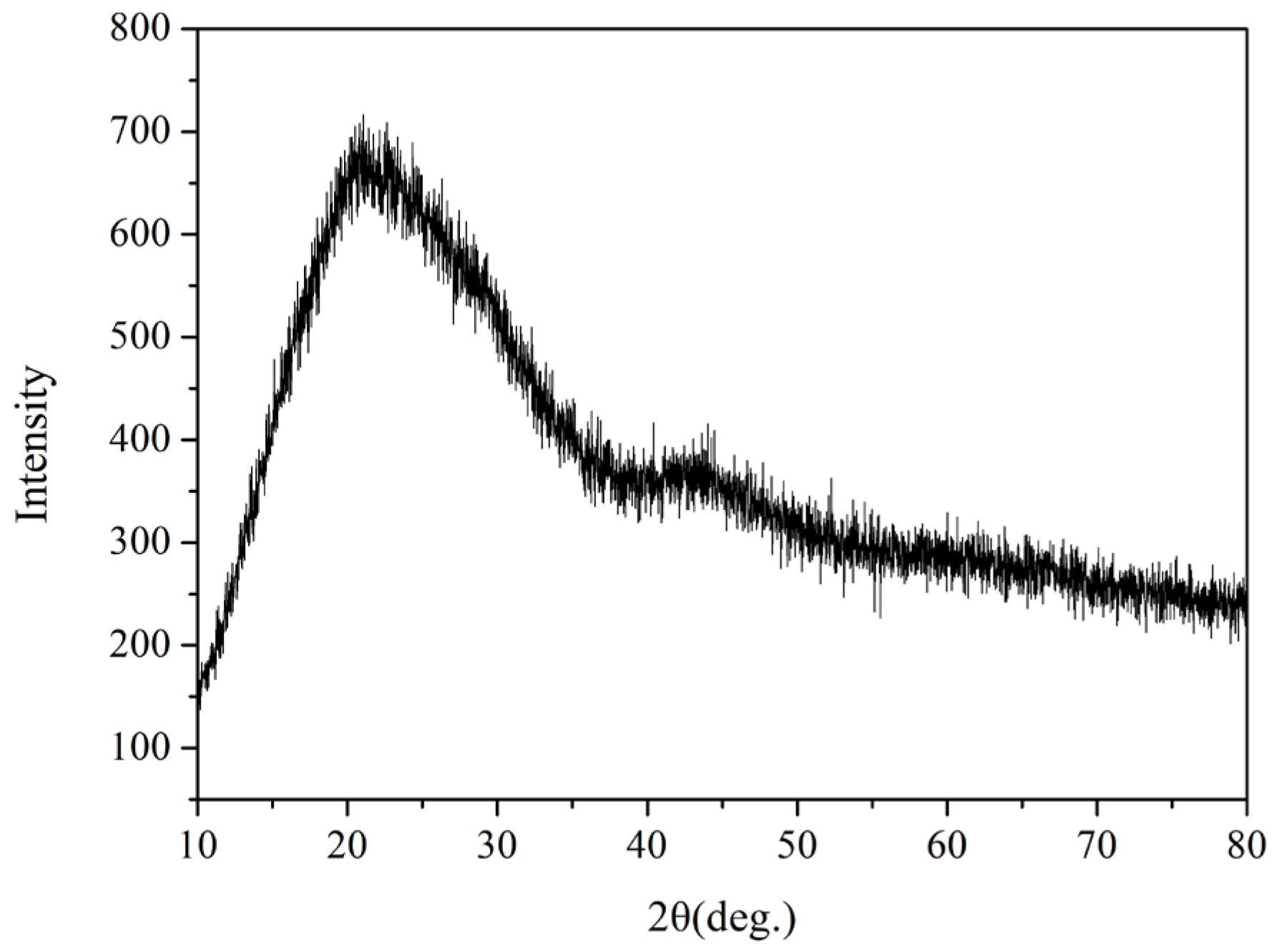
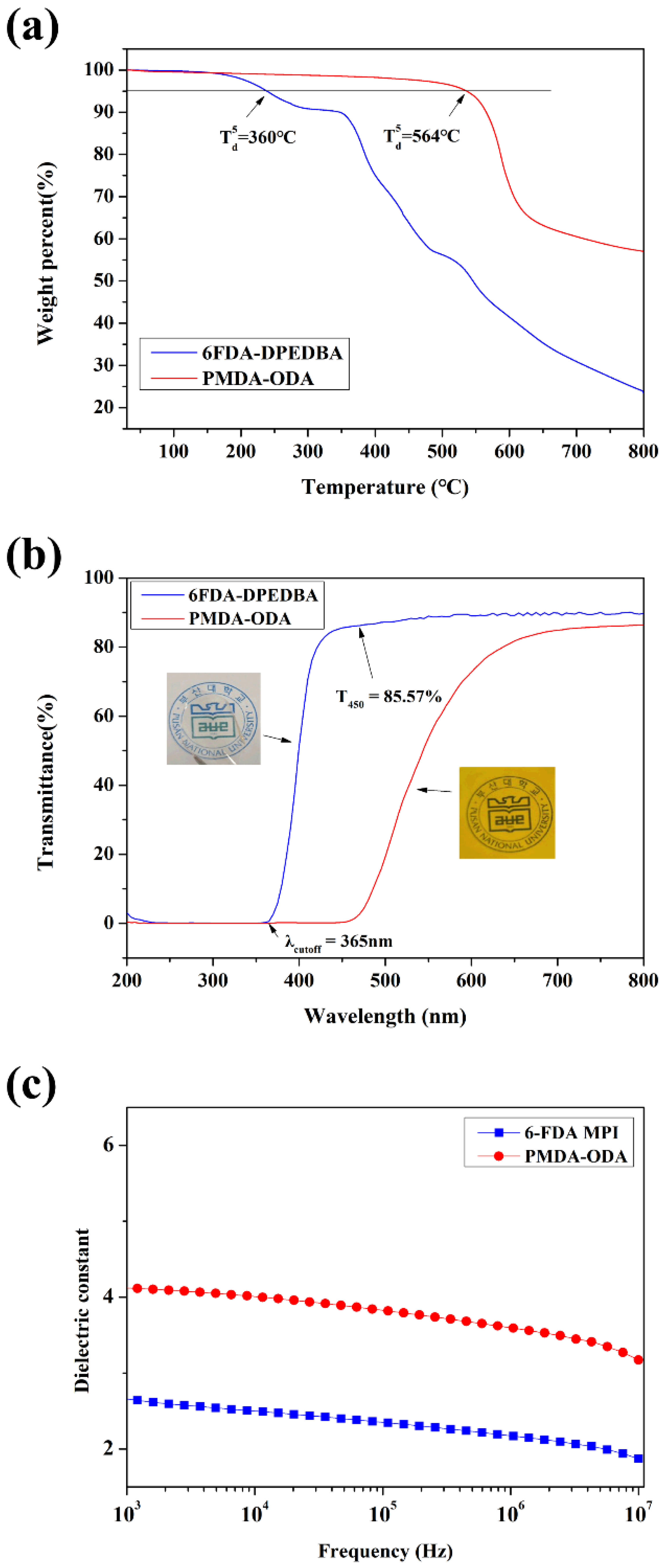
| Solvent | DMSO | DMAc | DMF | NMP | THF | CHCl3 | CH2Cl2 | Ethyl Acetate | γ-Butyrolactone | Ethanol | Methanol |
|---|---|---|---|---|---|---|---|---|---|---|---|
| ++ | ++ | ++ | ++ | ++ | ++ | ++ | ++ | + | − | − |
| PI | Tvis (%) | T450 (%) | T400 (%) | λcutoff (nm) | Δε(eV) | Film Thickness (μm) |
|---|---|---|---|---|---|---|
| 6FDA-DPEDBA | 87.1 | 85.57 | 51.1 | 365 | ~3.2 | 40 |
| PMDA-ODA | 55.0 | 0.29 | 0.18 | 465 | ~2.45 | 38 |
Publisher’s Note: MDPI stays neutral with regard to jurisdictional claims in published maps and institutional affiliations. |
© 2022 by the authors. Licensee MDPI, Basel, Switzerland. This article is an open access article distributed under the terms and conditions of the Creative Commons Attribution (CC BY) license (https://creativecommons.org/licenses/by/4.0/).
Share and Cite
Lee, J.S.; Yan, Y.-Z.; Park, S.S.; Ahn, S.-k.; Ha, C.-S. A Novel Diamine Containing Ester and Diphenylethane Groups for Colorless Polyimide with a Low Dielectric Constant and Low Water Absorption. Polymers 2022, 14, 4504. https://doi.org/10.3390/polym14214504
Lee JS, Yan Y-Z, Park SS, Ahn S-k, Ha C-S. A Novel Diamine Containing Ester and Diphenylethane Groups for Colorless Polyimide with a Low Dielectric Constant and Low Water Absorption. Polymers. 2022; 14(21):4504. https://doi.org/10.3390/polym14214504
Chicago/Turabian StyleLee, Jun Seok, Yong-Zhu Yan, Sung Soo Park, Suk-kyun Ahn, and Chang-Sik Ha. 2022. "A Novel Diamine Containing Ester and Diphenylethane Groups for Colorless Polyimide with a Low Dielectric Constant and Low Water Absorption" Polymers 14, no. 21: 4504. https://doi.org/10.3390/polym14214504
APA StyleLee, J. S., Yan, Y.-Z., Park, S. S., Ahn, S.-k., & Ha, C.-S. (2022). A Novel Diamine Containing Ester and Diphenylethane Groups for Colorless Polyimide with a Low Dielectric Constant and Low Water Absorption. Polymers, 14(21), 4504. https://doi.org/10.3390/polym14214504







